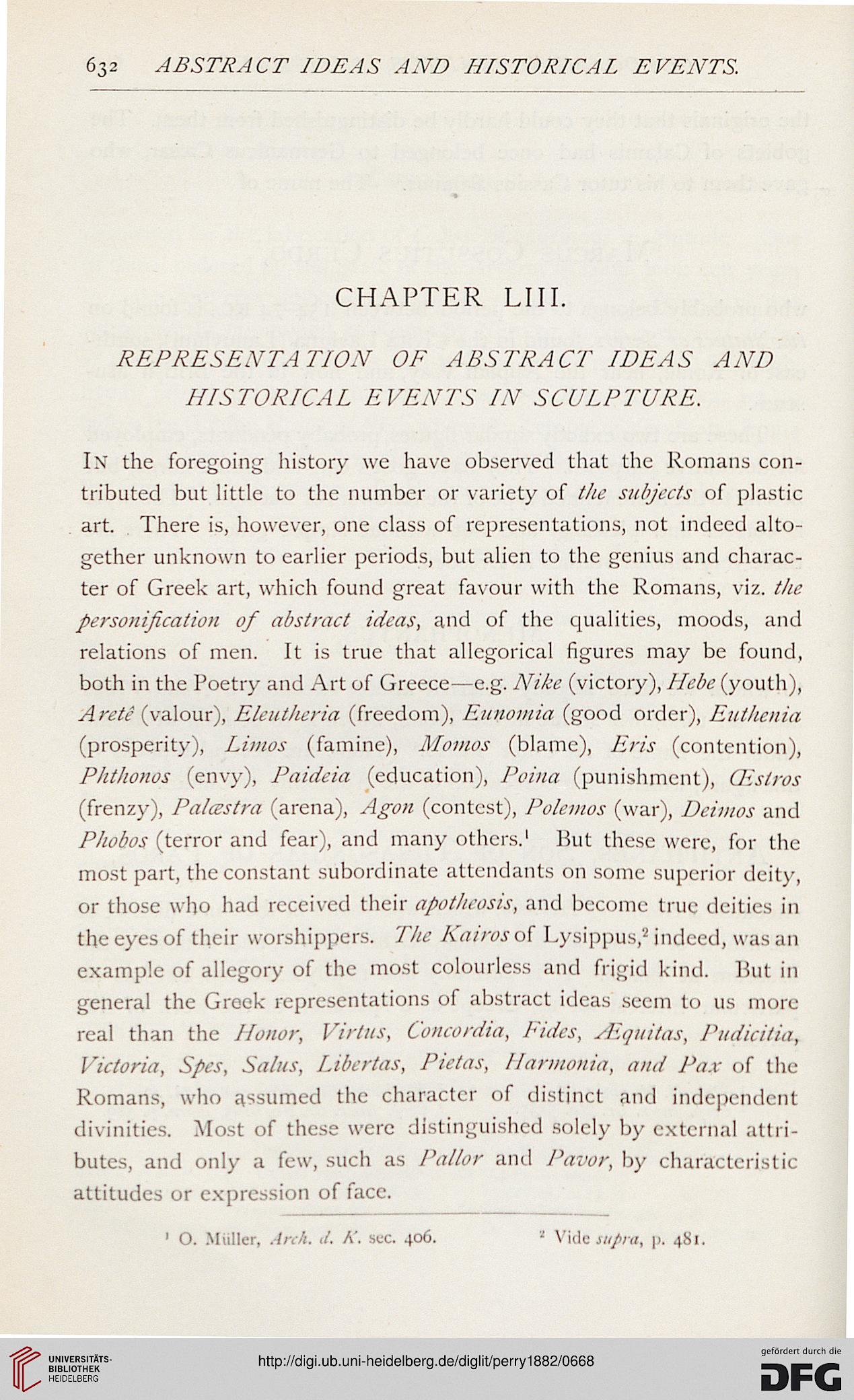632 ABSTRACT IDEAS AND HISTORICAL EVENTS.
CHAPTER LI 11.
REPRESENTATION OF ABSTRACT IDEAS AND
HISTORICAL EVENTS IN SCULPTURE.
In" the foregoing history we have observed that the Romans con-
tributed but little to the number or variety of the subjects of plastic
art. There is, however, one class of representations, not indeed alto-
gether unknown to earlier periods, but alien to the genius and charac-
ter of Greek art, which found great favour with the Romans, viz. the
personification of abstract ideas, and of the qualities, moods, and
relations of men. It is true that allegorical figures may be found,
both in the Poetry and Art of Greece—e.g. Nike (victory), Hebe (youth),
A rete (valour), Eleutheria (freedom), Eunomia (good order), Euthcnia
(prosperity), Linus (famine), Motnos (blame), Eris (contention),
Phthonos (envy), Paideia (education), Poina (punishment), Qislros
(frenzy), Palaestra (arena), Agon (contest), Polemos (war), Deivios and
Phobos (terror and fear), and many others.1 But these were, for the
most part, the constant subordinate attendants on some superior deity,
or those who had received their apotheosis, and become true deities in
the eyes of their worshippers. The Kairos of Lysippus,2 indeed, was an
example of allegory of the most colourless and frigid kind. But in
general the Greek representations of abstract ideas seem to us more
real than the Honor, Virtus, Concordia, Fides, sEquitas, Pudicitia,
Victoria, Spes, Salus, Libertas, Pietas, Ilarmonia, and Pax of the
Romans, who assumed the character of distinct and independent
divinities. Most of these were distinguished solely by external attri-
butes, and only a few, such as Pa/tor ami Pavor, by characteristic
attitudes or expression of face.
1 0. Miiller, Anh. J. A', sec. 406. ' Vide supra, |>. 481.
CHAPTER LI 11.
REPRESENTATION OF ABSTRACT IDEAS AND
HISTORICAL EVENTS IN SCULPTURE.
In" the foregoing history we have observed that the Romans con-
tributed but little to the number or variety of the subjects of plastic
art. There is, however, one class of representations, not indeed alto-
gether unknown to earlier periods, but alien to the genius and charac-
ter of Greek art, which found great favour with the Romans, viz. the
personification of abstract ideas, and of the qualities, moods, and
relations of men. It is true that allegorical figures may be found,
both in the Poetry and Art of Greece—e.g. Nike (victory), Hebe (youth),
A rete (valour), Eleutheria (freedom), Eunomia (good order), Euthcnia
(prosperity), Linus (famine), Motnos (blame), Eris (contention),
Phthonos (envy), Paideia (education), Poina (punishment), Qislros
(frenzy), Palaestra (arena), Agon (contest), Polemos (war), Deivios and
Phobos (terror and fear), and many others.1 But these were, for the
most part, the constant subordinate attendants on some superior deity,
or those who had received their apotheosis, and become true deities in
the eyes of their worshippers. The Kairos of Lysippus,2 indeed, was an
example of allegory of the most colourless and frigid kind. But in
general the Greek representations of abstract ideas seem to us more
real than the Honor, Virtus, Concordia, Fides, sEquitas, Pudicitia,
Victoria, Spes, Salus, Libertas, Pietas, Ilarmonia, and Pax of the
Romans, who assumed the character of distinct and independent
divinities. Most of these were distinguished solely by external attri-
butes, and only a few, such as Pa/tor ami Pavor, by characteristic
attitudes or expression of face.
1 0. Miiller, Anh. J. A', sec. 406. ' Vide supra, |>. 481.




